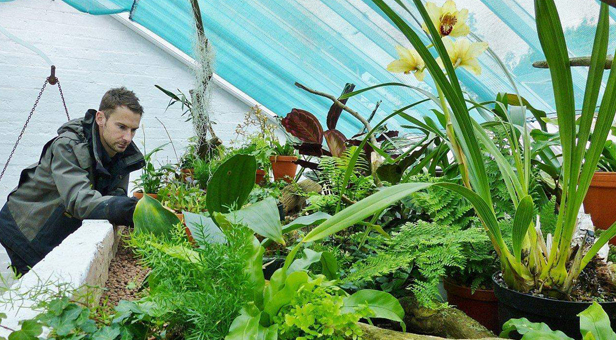
Garden lovers in Dorset will be able to step back in time and see a newly-restored Victorian orchid house which re-opened today 9 May at Kingston Lacy.
The orchid house was an important part of the kitchen garden at the house over 100 years ago but had tumbled into ruin over time. It has now been restored by the National Trust and is once again home to delicate orchids.
For fashionable Victorians a fascination with orchids was common with the word orchidelirium coined to describe the obsession. The passion for the exotic and fragile flowers was particularly seen at Kingston Lacy in Dorset, where Walter Ralph Bankes, and later Henrietta Bankes, developed their collection. The orchid house was part of a large complex of glass houses built at the kitchen garden which gradually fell into disrepair.
Since the National Trust took over Kingston Lacy in 1982, it has been a long held ambition to restore the orchid house.Thanks to a grant of £38,345 from Local Action Group Sowing Seeds, the National Trust has been able to restore the orchid house to its former glory.
The glasshouses are adjacent to the 118 Growing Spaces community allotment plots in the kitchen garden which has allocated spaces for local families and individuals, as well as community groups and schools.
The repairs have returned two of the glasshouses – one of them a ‘sunken’ glass house – to use again along with the small boiler house and cold frames, creating a new public area in the kitchen garden. The buildings were dismantled brick by brick and timber frames carefully dismantled so the replacements matched the originals as closely as possible.
Visitors will now be able to explore the glasshouse and an exotic variety of orchids – replicating those owned by the Bankes family – which were generously funded by a donation from the East Dorset National Trust Association.
Steve Candy, Head Gardener at Kingston Lacy, said: “Our gardens team has looked through the extensive archives from the Bankes family to find out more about the orchid collection at Kingston Lacy and how the Victorian gardeners cared for these plants. It’s really good to be able to allow people to experience Walter and Henrietta’s passion for orchids. Everyone will be able to enjoy the decorative and colourful, flower spiked displays in one of the few remaining examples of glasshouse in the UK.”
The Trust gardeners have also worked hard to save a 100 year old Wisteria which was growing on the Orchid House. The plant has been pruned back and supported on a specially made frame
Steve continued: “Saving the Wisteria is quite a challenge but it is an original feature of the building and as important as preserving the glasshouse itself.”
Researchers were able to draw on specific references to the orchids in the personal garden diary of Walter Bankes dating from 1896. On the Kingston Lacy library shelves is a copy of the “Amateur Orchid Cultivators’ Guide Book” (by H. A. Burberry published in 1894), inscribed with handwritten notes by Henrietta Bankes. The archives also hold receipts for the purchase of orchids from specialist nurserymen and even a schedule of work to fit wooden blinds to the orchid house to provide shading.
An important link to the past is a slipper orchid (Paphiopedilium insigne) with distinctive coppery gold colouring on its flower. This was grown and assembled with ferns, for posies and corsages, for sale at Wimborne market as late as the 1960s.
More information is available on www.nationaltrust.org.uk/kingstonlacy






